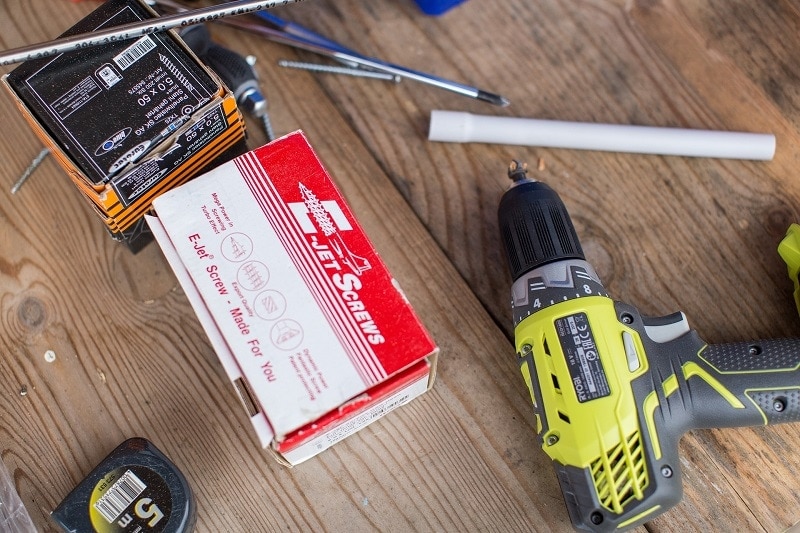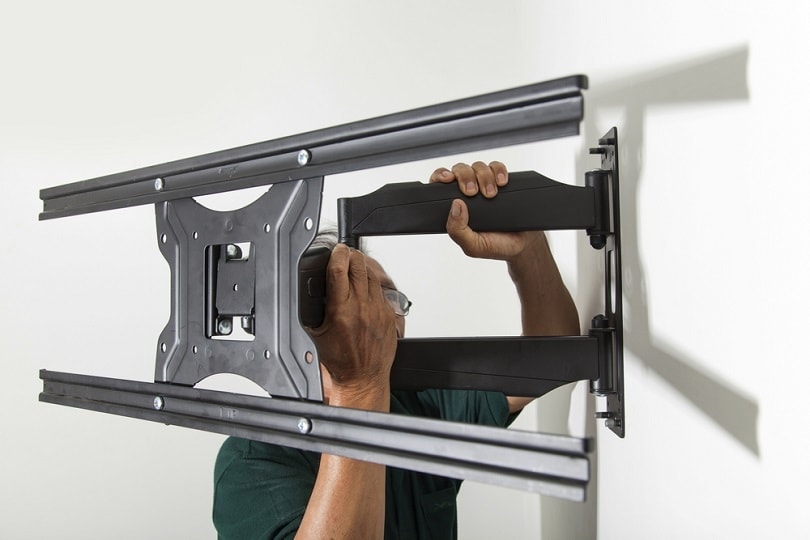How to Mount a TV on a Wall: 10 Expert Tips
-
Greg Iacono
- Last updated:

Years ago, televisions were more like a piece of large furniture with a TV built inside. Today’s flatscreen TVs are like large paintings. Sure, they come with feet, but most people hang them on the wall (like a painting) rather than stand them on a table or shelf.
There’s one significant difference between a painting and a flatscreen; you don’t tilt, swivel, pan, or extend a painting once it’s hanging on your wall. Doing those things with a flat-screen TV is necessary for the best viewing experience. For that, you need a TV mount. Below are 10 expert tips on how to mount a TV on a wall.

The 10 Expert Tips on How to Mount a TV On a Wall
1. Gather Your Tools Ahead of Time

When mounting a TV to a wall, you need to be prepared as much as with any other project. Organizing your tools will make it easier and less frustrating, especially if you encounter any problems. Plus, you won’t have to stop every 5 minutes to go and grab another tool.
- Tape measure
- Heavy-duty drill, drill bits
- Socket set (some wall mount screws have hex heads).
- Level
- Carpenter’s Pencil
- Blue masking tape
- Stud finder
- Easy
- Fast
- Gets great results
- Might need to run and buy tools you don’t own
2. Test the Height Before Mounting the Mount
One of the most common mistakes people make when mounting a TV to a wall is to mount it too high or too low. The problem is that looking too far up or down can give you a sore neck and make the TV’s picture look clouded. Avoiding this height problem requires three people. The first two people need to hold up the TV in front of the wall where it will be mounted.
The third person needs to sit down where they would typically watch the TV. Then, they need to tell the two holding the TV whether to go higher or lower. It’s a relatively easy way to ensure that you get the height of your TV just right.
- Easy
- Fast
- Gets great results
- Relatively safe
- Three strong, capable people are needed.
3. Mark the TVs Wall Location with Blue Masking Tape

If you use Tip #1 to see where your TV should be mounted, use this tip to mark the location on your chosen wall. The easiest way is for the person not holding the TV to make a “corner” on the wall using two pieces of blue masking tape on each of the TV’s four corners.
Blue masking tape is best since it’s easy to see. Also, masking tape is made to be removed from walls without stripping the paint or leaving behind a sticky residue. Once all four corners have been marked with the masking tape, the two people holding the TV can put it gently back on the floor while the TV mount is attached.
- Easy
- Fast
- Gets great results
- You might need to buy masking tape.
4. Use a Stud Finder to Find the Center of Studs
Although flat-screen TVs don’t weigh much, their weight on a TV mount increases dramatically when you pull them away from the wall to tilt, swivel, or pan them for better viewing. For that reason, you must screw the four large screws most TV mounts come with into the center of a stud in the wall. The best way to find the center of a stud is with an electronic stud finder that you can purchase at any big-box home improvement store. Once you find the two sides of a stud, you can mark them with a marker or, even better, with a small strip of masking tape on both sides.
- Easy
- Fast
- Gets great results
- You need to purchase a stud finder
- Doesn’t work on concrete walls
5. Never Mount a TV Opposite a Window

Another classic mistake made when mounting a TV on a wall is to mount it opposite a window. The problem is that since TV screens are dark, they will reflect light, especially during the day. That reflected light can ruin your viewing pleasure, washing out the image on the screen. All you’ll see are the trees in your yard and whatever else might be outside the window.
- A better view of the TV screen
- Easy to do in most cases
- It might mean changing your TV mounting plan.
- Could take away the best spot in the room to mount the TV
6. Choose the Correct TV Mount
The most crucial differences between brands are their weight and size rating. Some are rated for small, lighter TVs, while others are rated for heavier TVs. There are flat-mount TV mounts, for example, and TV mounts that allow you to tilt, swivel, pan, or extend your TV once it’s mounted for a better viewing angle.
A mount that’s too small might fail if you hang a large TV on it. If you want to tilt, swivel, pan, or extend your TV, a flat-mount TV mount can’t do that. Lastly, choosing a more expensive support made for a large TV will be a waste of money if you have a smaller TV.
- A quality mount will not fail when bumped accidentally
- You can watch TV from different angles
- The wrong TV mount might fail and destroy your TV.
7. Use Masking Tape to Measure the Pilot Holes Perfectly

If you’ve just moved and are mounting your old TV mount in a new home or apartment, you might not have the mounting guide or instructions. In this case, masking tape is a great way to ensure you drill the pilot holes in the correct spot.
- Lay your TV mount on a stable, flat surface.
- Stretch out a piece of masking tape, so it’s a few inches longer than the distance between the top two screw holes of the TV mount.
- Use a pencil or marker to mark where the holes are.
- Remove the masking tape.
- Using a level, place the masking tape on the wall.
- Drill the holes where they are marked on the tape.
- Repeat the process for the bottom row of holes.
- Easy and accurate
- Costs almost nothing
- You still need someone to help you decide the correct mounting height.
8. Don’t Forget the Cords and Cables
Many people forget the cords and cables when installing a TV mount on the wall. Once it’s mounted, putting the cables in the wall or hiding them will be difficult. Run your cables and chords to the mounting location to avoid the problem. If you can run them through the wall to a new outlet, that would be ideal. If not, a cord cover might be necessary. Either way, doing this before you mount the TV to the wall is crucial.
- Cables and cords will reach the TV with no problem.
- Cables and cords will be hidden.
- Running cables and cords in the wall takes time and expertise.
- You need to purchase a cord cover.
9. Use Toggle Anchors or Molly Bolts When There Are No Studs

Some walls have no studs or studs that are too far apart to use when hanging your TV on the wall. In those cases, the best choice is to use toggle anchors or molly bolts. These are specialized screws that, when screwed into drywall or paneling, attach to the inside of the wall with a butterfly toggle.
If you use this method, it’s recommended that you also use a flat-mount TV mount. One that tilts and extends might put too much weight on the anchors or bolts and cause the TV to come crashing down.
- Easy solution when there are no or few studs
- Easy to attach to the wall.
- It might not provide enough support.
- You might need extra toggle anchors or molly bolts for more support.
10. Plug in Cords and Cables Before Mounting to a Flat Mount
One small problem with flat-mount TV mounts is that accessing cable ports is sometimes impossible once the TV is on the wall. That means you must take the TV back down, plug in the cables, and put the TV back on the mount again.
- Easy and fast
- No need to take the TV back down again
- You might need a cable or cord extension.

Final Thoughts
Mounting your TV on your wall correctly is essential for your viewing enjoyment. The 10 Tips provided today should help you finish the job flawlessly and safely so that your TV is mounted in the perfect position. Be sure to have your tools ready and ask one or two friends or family members to help. If you do and follow the 10 tips provided today, mounting your TV on the wall should be relatively quick and painless. Best of luck, and enjoy watching your favorite movies and shows!
- Related Read: 8 Best Wall Mount Speakers: Reviews & Top Picks
Featured Image Credit: RossHelen, Shutterstock
Contents